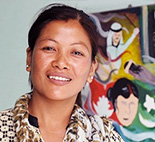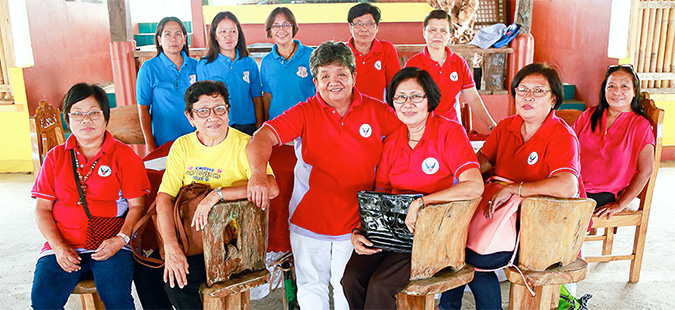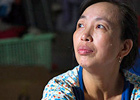Women refugees and migrants
Author: Sara De La Pena Espin

| Infographics | Snapshots | From where I stand... | Photo essays | Speeches and statements |
| More stories | Publications |
The issue
Today, around the world, people are on the move. They are migrating to escape poverty, improve their livelihood and opportunities, or escaping conflict and devastation in their own countries. Women represent almost half of the 244 million migrants and half of the 19.6 million refugees worldwide [1].
The remittances sent by women migrant workers improve the livelihood and health of their families and strengthen economies. In 2015, international migrants sent USD 432.6 billion in remittances to developing countries—nearly three times the amount of Official Development Assistance, which totaled at USD 131.6 billion [2].
Women are often the first responders in a crisis, and whether en route or in camps, in home countries or destination countries, they play a crucial role in caring for, sustaining and rebuilding their communities.
Yet, refugee and migrant women’s needs, priorities and voices are often missing from policies designed to protect and assist them.
Fast facts
- Between 2000 and 2015, the number of international migrants has increased by 41 per cent to reach 244 million. Almost half of them are women [3].
- Migrants, especially migrant women, have higher labour force participation rates (72.7 per cent) than non-migrants (63.9 per cent) [4].
- Almost every sixth domestic worker in the world is an international migrant, and women make up 73.4 per cent of international migrant domestic workers [5].
- Yet, only 22 countries have ratified the ILO Convention on Domestic Workers (No. 189), which recognizes the additional vulnerabilities of women domestic workers and protects the rights and dignity of all domestic workers.
- Today, 50 per cent of the world's refugees are women and girls [6]. Yet, only 4 per cent of projects in UN inter-agency appeals were targeted at women and girls in 2014, and just 0.4 per cent of all funding to fragile states went to women’s groups or women’s ministries from 2012 to 2013 [7].
- According to UN reports, 60 per cent of preventable maternal deaths take place in humanitarian settings and at least 1 in 5 refugees or displaced women are estimated to have experienced sexual violence [8].
- The number of internally displaced persons stood at almost 40 million at the end of 2014. Current data suggests that women living in protracted displacement slightly outnumber men and their hardships get worse over time [9].
Placing women in decision-making roles and including their needs and realities in policies and solutions designed to address global migration and the refugee crisis make them more sustainable and responsive.
Infographics
Looking for more facts and figures? See our related infographics.
The United Nations Summit for Refugees and Migrants
Addressing the unprecedented large movements of refugees and migrants needs a more humane and coordinated approach that all countries can endorse and implement. On 19 September, on the occasion of the 71st session of the UN General Assembly, Heads of State and Governments will come together at the first-ever high-level summit for refugees and migrants to discuss the key elements of a global compact for safe, regular and orderly migration and a global compact on responsibility-sharing for refugees.
The day-long summit is expected to generate global commitments to address the root causes of large movements of refugees and migrants; to ensure at all stages, the human rights, safety and dignity of refugees and migrants; to provide protection from violence; and to prevent discrimination and xenophobia. World leaders are also expected to discuss a more predictable and equitable way of responding to large movements of refugees through responsibility-sharing and a comprehensive response plan for refugees.
With refugee and migrant women playing a pivotal role around the world to sustain communities and economies, the global commitments must include achieving gender equality, the empowerment of all women and girls and their human rights as underlying principles, address the unique needs of women and girls, include their voices, and be accountable to them.
Snapshots of our work
Towards safe migration and decent work for women in Nepal
Dawa Dolma Tamang migrated from rural Nepal to Abu Dhabi because she wanted to improve her livelihood and support her family. She ended up paying seven times more than what was required to the recruiting agency and was wrongfully denied work on medical grounds. Today, Tamang is working as a mason and will soon start taking the vocational and entrepreneurship skills training provided by a UN Women programme that is advancing women’s economic empowerment in Nepal... more
Empowering domestic workers through information technology in Cambodia
Research shows that domestic workers in Cambodia need access to and information about physical and mental health. A new technology supported by UN Women empowers them towards a healthier life... more
From where I Stand
This editorial series captures the unique and powerful stories of people around the world, through compelling first-person accounts of their daily sustainable development challenges and how they are bringing about change. Read more»
“The main challenge for women migrant workers is that they don’t know what rights they have....”
Photo Essays
In the Philippines, women migrant workers rebuild lives, advocate for each other
A global programme by UN Women, “Promoting and Protecting Women Migrant Workers’ Labour and Human Rights”, supported by the European Union and piloted in the Philippines, works to build the capacities of migrant women’s organizations and networks to better serve and assist women migrant workers.
In the past two decades, an annual average of 172,000 Filipino women have left the country as migrant workers, in the quest for decent work and adequate income. Many endure abuse and exploitation and need reintegration support upon return. A UN Women programme is strengthening the capacity of migrant women’s organizations and networks to better serve and assist women migrant workers.
Speeches and Statements
- UN Women statement on World Refugee Day (20 June)
In a statement for World Refugee Day on 20 June, UN Women calls for urgent action to ensure refugee women and girls have access to secure transit routes, safe spaces and protection when they arrive in a host country, and resources and services that will help them to build a post-conflict life free from violence and poverty - Deputy Executive Director calls for cooperation to ensure safety and dignity of migrants and refugees (18 May)
Remarks by UN Women Deputy Executive Director Lakshmi Puri at the “Large Movements of Refugees and Migrants: Critical Challenges for Sustainable Urbanization” event on 18 May in New York.
Videos
The real-life tale of a domestic worker
Snow White is from Karen State, Myanmar. Her father died when she was 11, leaving her responsible for the care of her mother and younger siblings. Lacking opportunity and education in her hometown, Snow White joined a group of friends hoping to be smuggled into Thailand to find work as domestic workers, setting off a harrowing journey that nearly left her dead. Watch our story to find out how Snow White’s story unfolds.
295,000 refugees flee political violence in Burundi
A year after political violence erupted in Burundi, 295,000 people have fled to neighboring Tanzania and Democratic Republic of Congo. More than half of those fleeing are women and children, who face not only food shortage and poverty, but also higher rates of sexual and domestic violence, and increased chances of early/child marriage. UN Women sets up “Safe Spaces” in refugee camps to offer income opportunities and business training for women, as well as psycho-social counselling and trauma assistance.
More Stories
Creating “happy homes” for domestic workers in Asia Pacific
Live-in domestic workers in the Asia Pacific region often experience multiple abuses. The innovative Happy Home Campaign has launched a video series to raise awareness of the rights and obligations of domestic workers and their employers. The campaign encourages employers to take the lead in creating happy home environments... more
From where I stand: Khet Kumari Ghimere
When she was 21, Khet Kumari Ghimere migrated to Kuwait as a domestic worker. Overworked, abused and underpaid, she returned to Nepal after two years. Today she works as a security guard at the emergency shelter for migrant women run by the organization, Pourakhi, which is supported by UN Women... more
Migrant women of Viet Nam claim social protection and rights
An estimated 40 – 50 per cent of migrants in Hanoi and Ho Chi Minh City, the two biggest cities in Viet Nam, are women, and they face distinct challenges. More than 10,000 migrant workers have learnt how to access social welfare benefits, legal protection, health care and more through a programme supported by UN Women’s Fund for Gender Equality... more
Publications
Women Migrant Workers' Human Rights
UN Women’s series Transforming Our World presents succinct thematic documents with the aim of raising awareness on the importance of tackling inequality and on the legal framework that protects the rights of women as well as promote solutions to these issues from all areas of society... more
This publication aims to enhance the existing knowledge and resources on the current situation of the Filipino migrant workers with particular attention to the gender dimensions of migration. It includes accessible sex-disaggregated data and analysis of women migrants’ profiles... more
The Effect of Gender Equality Programming on Humanitarian Outcomes
Based on evidence gathered directly from crisis-affected populations, “The Effect of Gender Equality Programming on Humanitarian Outcomes” study presents a compelling case that gender equality programming makes a positive contribution to improving humanitarian outcomes. The study also provides practical recommendations on the best means to integrate gender equality programming into future humanitarian interventions in ways that strengthen effectiveness and inclusiveness... more
Women Migrant Workers in ASEAN
This Policy Brief takes a broader view of women’s labour migration in ASEAN and considers both the economic and non-economic contributions that they make. Recognising that women labour migrants face gender specific challenges and barriers, this Policy Brief provides recommendations to policy-makers on how to ensure the potential of women migrant workers is maximized to benefit the individual migrant, her family and her community while avoiding simplifying women migrant workers as tools of economic development... more
Notes
- UN General Assembly (2016). In safety and dignity: addressing large movements of refugees and migrants, Report of the Secretary-General.
- The World Bank Group (2015). The Migration and Remittances Factbook 2016
- UN General Assembly (2016). In safety and dignity: addressing large movements of refugees and migrants, Report of the Secretary-General.
- ILO (2015). ILO global estimates on migrant workers
- Ibid. p.7
- UNHCR http://www.unhcr.org/en-us/women.html
- UN OCHA (2015) World Humanitarian Data and Trends, p. 23.
- United Nations Economic and Social Council (2014) Gender equality and the empowerment of women in natural disasters, Report of the Secretary-General.
- Internal Displacement Monitoring Centre (2015). Global Overview 2015, People internally displaced by conflict and violence.
![[IMAGE]](/sites/default/files/Field%20Office%20ESEAsia/Images/2016/09/info-refugee-330px.jpg?la=en&h=229&w=300)
![[IMAGE]](/sites/default/files/Field%20Office%20ESEAsia/Images/2016/09/info-migrant-worker-330px.jpg?la=en&h=229&w=300)







